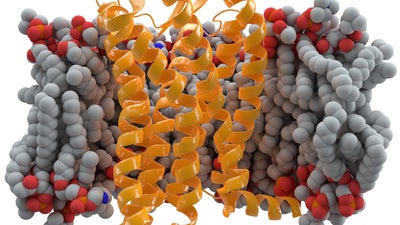Leukaemia
Leukaemia is a type of blood cancer that affects blood cells in your bone marrow.
CML – Characteristics and symptoms
Chronic myeloid leukaemia (CML) has a relatively mild but long course. Cancer changes are caused by chromosome mutation. Two out of twenty-three chromosome pairs in human cell nuclei are wrongly translocated, leading to the so-called Philadelphia chromosome and the defective gene. That gene causes the granulocyte cells in bone marrow to reproduce rapidly in an uncontrolled way, resulting in too many of them entering the blood.
Chronic myeloid leukaemia develops in stages. Each stage has its own signs and symptoms. Initially, they are not numerous, but with the accumulation of immature blood cells, various ailments may intensify, indicating disease progression.
There are three phases of chronic myeloid leukaemia:
- Chronic phase,
- Accelerated phase
- Blast crisis
Fortunately, in most cases the disease is diagnosed during the first stage, when the symptoms are still minor. However, sometimes the leukaemia is detected in its advanced phase, when it progresses rapidly.
Characteristics of the chronic phase
The primary abnormality occurring in this phase, which is also the longest phase of the disease, is an excessive white blood cell count, even if those cells are still functioning correctly. During this phase various minor symptoms occur, such as chronic fatigue, headaches and limb pains. Enlargement of the spleen (manifested by discomfort or pain in this part of the body) and weight loss may also occur. The disease is normally diagnosed by a basic blood test and a quick intervention with different treatment options can stop the progress of the disease.
Characteristics of the accelerated phase
During this phase, the disease progresses faster. The continued multiplication of pathological blast cells (leukaemia cells) causes them to move faster from the bone marrow to the peripheral blood. Over time, the spleen and liver are affected by the disease. Symptoms from the first phase intensify, with night sweats and stronger pain occurring, as well as symptoms characteristic for anaemia. Anaemia, which results from a deficiency of properly functioning red blood cells, causes paleness of the skin and mucous membranes, permanent fatigue and lethargy, as well as dyspnea (shortness of breath) and decreased exercise capacity. Diagnosing leukaemia in this phase still provides a good chance for effective treatment, although the prognosis is slightly worse.
Blastic crisis characteristics
The final phase of the disease is characterised by its highest aggressiveness. During this stage, chronic leukaemia begins to behave like an acute form of leukaemia. Blasts are precursors to mature, circulating blood cells. Mutant neoplastic blast cells divide very quickly, displacing other healthy blood cells. It is manifested by frequent and recurring infections that cannot be cured by standard treatment. In addition, patients are diagnosed with haemorrhagic disorders, i.e., blood clotting disorders caused by reduced platelet count. The disease at that phase is usually treated like acute leukaemia and the prognosis is worse.
AML - Characteristics and symptoms
Acute myeloid leukaemia is a malignant neoplasm (abnormal growth of cells) of the haematopoietic system. The disease causes the maturation and differentiation of bone marrow precursor cells, which is caused by genetic mutation. Immature, clonal (i.e. identical to each other) neoplastic cells, known as blasts, accumulate in the bone marrow. Under normal conditions, there are only very few immature cells in the human body, but the neoplastic changes cause blasts to proliferate rapidly and uncontrollably. Healthy blood cells are progressively displaced by pathological cells, causing organ failure and resulting in death in a very short period of time.
Acute myeloid leukaemia is the most common form of leukaemia diagnosed in adults. The risk of the disease increases with age; the average age of patients is 65 years. Among children this type of leukaemia is not as common, attacking about 10% of young patients suffering from malignant neoplasms.
Early diagnosis of myeloid leukaemia is very difficult, as most of its initial symptoms are typical for a variety of minor, non-specific conditions and infections. Therefore, special attention should be paid to the co-occurrence of several symptoms and a lack of response to the prescribed treatment.
The main signs and symptoms include:
- Frequent and recurring infections resulting from decreased immunity. As a result of the uncontrolled growth of cancer cells the number of leukocytes (white blood cells) is disturbed and their function is impaired. This results in recurrent and severe infections that do not respond to treatment - e.g. antibiotics.
- Anaemia. Anaemia is caused by a decrease in the number of red blood cells (displaced by pathological cells), which are responsible for the transportation of oxygen throughout the body. Symptoms include weakness, lethargy, paleness of mucous membranes and the skin, accelerated heart rate, chronic feeling of fatigue and a general decrease in physical performance.
- Haemorrhagic disorders, caused by a deficiency of properly functioning platelets (thrombocytes) - responsible for blood clotting - or a significant decrease in their number. Haemorrhagic disorders may be manifested by petechiae (tiny purple, red or brown spots) on the skin (especially on limbs), bleeding that is very difficult to stop (even in the case of minor injuries), bleeding gums and nosebleeds, easy bruising and bloody spots under the skin, as well as haematuria (blood in the urine).
Other worrying symptoms include:
- Severe bone pains (arms, legs, head, joints).
- Fevers and night sweats.
- Inflammation of oral mucosa and further sections of the gastrointestinal tract.
- The loss of appetite resulting in, among other things, weight loss.
CLL – Characteristics and symptoms
Chronic lymphocytic leukaemia (CLL) is the most common form of leukaemia in the western world and occurs mainly in older age. CLL can present mild symptoms for years and may not require any treatment, but it can also turn aggressive and due to its typical resistance to treatment, can lead to death.
CLL occurs when there is uncontrolled proliferation and accumulation in the blood and bone marrow (sometimes also in lymph nodes, spleen and liver) of neoplastically changed lymphocytes (white blood cells). As the disease progresses, the changed lymphocytes displace healthy blood cells.
The causes of CLL are not known, but scientists assume that genetic predisposition is an important factor in its development.
The most common symptoms of CLL include:
- Painless enlargement of lymph nodes.
- Increased temperature lasting for a longer period, about 2 weeks.
- Night sweats.
- Fatigue.
- Weight loss.
However, it is rare for patients to have all of the symptoms, as a large number of cases are asymptomatic.
ALL – Characteristics and symptoms
Acute lymphoblastic leukaemia (ALL) is a malignant neoplasm (abnormal growth of cells) of the haematopoietic system, characterised by a very rapid progression of the disease. This type of leukaemia mainly affects young people (up to 30 years old). Acute lymphoblastic leukaemia is the most common neoplasm among children (especially in the age of 2-10 years) and represents 75% of blood cancer diagnoses in that age group.
Acute lymphoblastic leukaemia is a disease where, as a result of genetic mutations in bone marrow cavities, uncontrolled growth of lymphoblasts occurs. Lymphoblasts are immature lymphocytes, which is a type of white blood cell (leukocyte). These lymphoblasts lose their ability to differentiate and mature, which prevents them from functioning correctly. Those cells do not reach maturity and quickly impede and displace healthy blood cells. At the same time, the number of properly functioning red blood cells, white blood cells and platelets decreases. Although the absolute number of white blood cells may be much higher than normal, their functions are lost, so they no longer protect the body from infections.
Most early symptoms often go unnoticed at first, as they are typical for ordinary, mild conditions and as a result are ignored by many patients. However, with this type of leukaemia the symptoms become more severe very quickly and do not disappear after standard treatment for infections. In such cases, a full blood count should be performed immediately and in case any irregularities are found, subsequent tests should be performed.
The most significant symptoms that may indicate the disease include:
- Blood clotting disorder or blood diathesis. It manifests through easy bruising on the body, even by slight blows or abrasions, and through the formation of small reddish spots on the skin. Other symptoms include the presence of blood in urine, as well as gum and nose bleeding which is difficult to stop.
- Pain in muscles and joints (especially in the limbs) and frequent limb numbness.
- Fever and night sweats.
- Anaemia caused by red blood cell deficiency. The presence of anaemia may cause a feeling of permanent fatigue, decreased ability to exercise, lethargy and sleepiness, as well as pale skin.
- Frequent infections which, despite antibiotic treatment, recur. This is caused by the influence of cancer cells on the immune system. Healthy leukocytes are displaced by pathological cancer cells, making the body increasingly susceptible to various viral, bacterial and fungal infections.
- Loss of appetite and weight loss.
- Enlarged lymph nodes.
- Stomach pains caused by spleen and/or liver enlargement.


